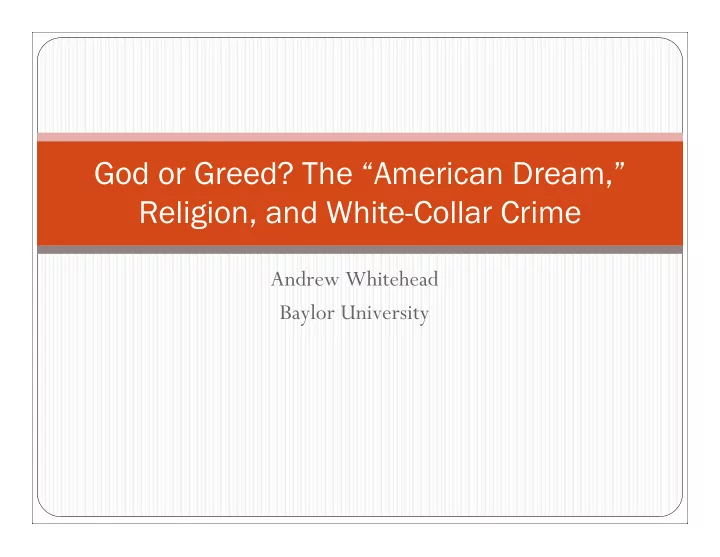

God or Greed? The “American Dream,” Religion, and White-Collar Crime Andrew Whitehead Baylor University
Overview � Institutional Anomie Theory � Moral Communities Thesis � White-Collar Crime � Does the pressure to achieve economic success dominate the ethical demands made by most religions?
Institutional Anomie Theory � Messner and Rosenfeld build from Robert Merton’s work on “anomie” � High crime rate in US due to uneven emphases � Name emphasis on monetary success “American Dream” � “American Dream” interacts with social structure found in US � Family, Polity, and Education all dominated by the Economy
Institutional Anomie Theory � Sanctioning and regulating ability of Family, Education, and Polity lost � “American Dream” pursued by any means necessary � Strengthen noneconomic institutions to reduce levels of anomie
Institutional Anomie Theory � Various levels of support for theory � Support: Baumer and Gustafson 2007, Hannon and DeFronzo 1998, Maume and Lee 2003, Messner and Rosenfeld 1997, Savolainen 2000 � Mixed: Piquero and Piquero 1998, Cullen et al. 2004, Batton and Jensen 2002 � No Support: Jensen 2002, Cao 2004 � Testing institutional aspects of theory as well as cultural � Various ways to operationalize the various institutions
White-Collar Crime and IAT � White-Collar Crime Theories � Fear of falling (Weisburd et al. 1991) � Low self-control (Benson and Moore 1992, Simpson and Piquero 2002) � Desire for control (Piquero et al. 2005) � White-Collar Crime and IAT � Effects of anomie applicable to all sectors of society � Lack of noneconomic institutional regulation of behavior
White-Collar Crime and IAT � Schoepfer and Piquero (2006) � Mixed support for IAT: economy, polity, and education all associated with white-collar crime levels
Religion and IAT � Religion significantly associated with crime levels using IAT � Antonaccio and Tittle 2007, Baumer and Gustafson 2007, Chamlin and Cochran 1995, Cullen et al. 2004, Maume and Lee 2003 � Moral Communities Thesis � Religion is a group phenomenon not just individual one � Religious culture matters
Hypothesis � Higher overall levels of religiosity will result in lower levels of white-collar crime
Data/Methods � Follow closely Schoepfer and Piquero’s study � White-collar crime: Embezzlement rates per 100,000 for each state in 2001 � Economy: % unemployed � Family: Divorce to marriage ratio � Education: % of population not graduating high school � Polity: % of population who voted for US Representatives in their area in 2000 � Religion: adjusted total adherence rate as a % of state population (2000 RCMS)
Results Poisson Estimates of Embezzlement Rates 2001 Variable Estimate S.E. % Unemployed (Economy) -0.238** 0.074 % Not High School Grad (Education) 0.122*** 0.020 % Voted in Last Election (Polity) -0.013 0.009 Divorce to Marriage Ratio (Family) 2.159*** 0.425 -0.003 0.005 % Total Religious Adherence (Religion) Constant 0.789 0.740 Pseudo R² 0.171 p<.05 *; p<.01 **; p<.001 ***
Discussion � No effect for religion � White-collar criminals more religious? (Benson and Kerley 2001) � Mixed support for IAT when considering white-collar crime
Limitations � Operationalization � Economy � Religion � White-Collar Crime � Data � Uniform Crime Reports
Conclusion � Thankfully, there is no conclusion as of yet. Thank you!
Recommend
More recommend